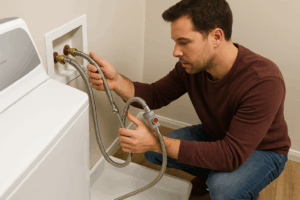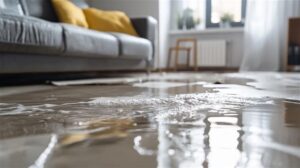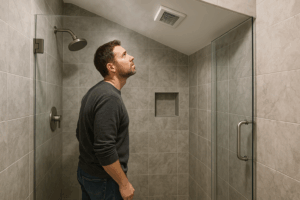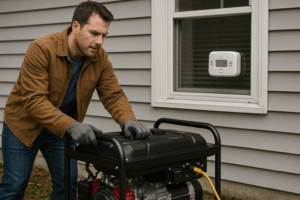Wildfires leave more behind than burned trees and distant smoke plumes. The smoke can leave your property covered in stains, residue, and odors that seem almost impossible to remove. As a mold remediation company owner, I see firsthand what lingering smoke does to home exteriors, decks, pools, patios, and outdoor items. This guide shows you how to shield your property, handle wildfire smoke cleanup, and restore comfort and beauty after nearby burns.
Effects of Wildfire Smoke on Outdoor Areas
Wildfires spread fine particles that cling to everything outside including siding, fences, decks, and outdoor furniture. Soot and ash settle on surfaces where wind and gravity drop them. Black film on siding, greasy stains on deck wood, or mysterious residue on your metal fixtures signal wildfire smoke contamination. These particles are more than an eyesore. They contain chemicals that harm paint, metal, plastic, and fabric. Vinyl siding exposed to smoke film ages quickly and may develop cracks. Outdoor furniture left uncovered fades rapidly, stained by dark soot and embedded ash. Metal surfaces blemish and corrode under smoke residue. Even stone patios or pavers stain deeply and may become slick after smoke contact.
Wildfire smoke contains more than dust. Toxins and tars land along with ash. These residues may irritate your skin, nose, and throat. During cleaning, many homeowners notice coughing, watery eyes, or skin discomfort when residues linger. Read more about health effects directly from public health authorities at publichealth.lacounty.gov. Protecting your property starts with understanding the persistent damage wildfire smoke can cause even if flames never reach your address.
Cleaning Soot and Ash From Outside Surfaces
Smoke leaves tough residues. Quick and correct wildfire smoke cleanup prevents damage from becoming permanent. Rinse or sweep away loose ash but avoid using leaf blowers. A leaf blower sends harmful particles airborne, risking both your health and the wider area. Instead, use gentle streams from a hose to soak surfaces and guide ash to the ground. Pressure washers work well if your surfaces can tolerate them. Be careful with soft wood or loose paint which can gouge in the process. For most homes, a garden hose paired with a spray nozzle offers a safe starting point.
After rinsing surfaces, focus on detail work. Windows and glass doors often trap a sticky film. Use a damp microfiber cloth and mild soap. Rinse residue regularly to keep contaminants from scratching glass. For stubborn siding or deck stains, choose a product meant for smoke or soot. Dilute heavy cleaners fully and always read labels to avoid bleach damage or unwanted discoloration. Do a test patch first in a hidden spot. For brick, stone, or stamped concrete, repeat gentle washes and avoid scrubbing with wire brushes, which may embed residue further. Regular rinsing combined with occasional mild cleansers pulls up deep stains caused by wildfire smoke.
Outdoor Furniture and Fabric Restoration
Outdoor furniture often takes the brunt of wildfire smoke. Fabric cushions, pillows, umbrellas, and rugs become discolored or retain odors. If items are visibly covered in soot or show strong odors after washing, consider laundering covers if they are removable. Use the warmest water recommended on the label and mix in a cup of baking soda for added deodorization. Rinse thoroughly before air drying. For non-removable fabric or for cushions deeply penetrated by smoke, replacement may be better than endless washing. For wood, metal, or plastic furniture, use mild soap and water, then wipe surfaces down with a damp cloth. Avoid using bleach on metals or plastics, as it accelerates corrosion or fading.
Protect clean items promptly after washing. Good outdoor covers make a major difference during future fires. Furniture covers block much of the residue before it settles and prevent odors from becoming permanent. Store smaller cushions or pillows indoors during wildfire season or during local fire events if possible. This reduces your cleanup time and keeps fabrics looking fresher longer.
Maintaining Air Quality Outdoors and Indoors
Wildfire residue is not just a visual nuisance. Each particle represents a potential respiratory hazard, even long after smoke fades from view. After fire events, monitor local air quality indexes daily. Many weather apps show up-to-the-minute air quality data. Cleaning while outdoor air quality is low can spread particles further. For best results, focus your wildfire smoke cleanup after winds settle and outdoor air improves.
Inside the home, use portable air purifiers with HEPA filters to reduce microscopic particles. Replace HVAC filters more often during and after local wildfires. Open windows only when air quality readings are in the green. Use window fans to circulate and clear smoky odors trapped indoors once you are sure fresh air is safe. Change bedding, wash washable curtains, and wipe hard surfaces to collect stray residues that have entered through rarely sealed leaks or open doors.
Protecting Home Exteriors Before Wildfire Season
Preparation stops wildfire smoke from causing lasting harm. Inspect your siding, decks, doors, and windows for leaks or gaps. Replace cracked window caulk and worn weather stripping. Check vent covers, attic vents, and crawlspace openings for any break in their seal. Even tiny gaps let smoke in. Seal mail slots, pet doors, or any utility holes leading outdoors before local wildfires spark up.
Tie back shrubs and trim tree limbs at least three feet from your siding. Remove dead leaves or debris in corners or gutters, as these materials both attract smoke and present added fire risk. Grills, patio heaters, and outdoor appliances benefit from tight vinyl or canvas covers. Even brief exposure during wildfires can stain chrome, fade color, or warp plastics. If possible, move smaller play items or outdoor tools into garages or sheds until air clears. These efforts not only protect home exteriors but also reduce future labor and costs as part of your wildfire season preparation.
Restoring Property After Smoke Exposure
Some tasks go beyond a simple rinse. Pools gather significant ash which clogs filters and skimmers. Clean the surface with fine mesh skimmers. Flush the filter system and replace cartridges where needed. Test water for pH and chlorine balance after rinsing, as ash can throw off your chemistry. Avoid vacuuming until large residues are gathered. According to pool maintenance experts at BobVila.com, patience and repeated cleaning restore pools to normal use.
Sod and gardens become coated with a grey film that may linger. Light watering helps settle ash particles into the soil and prevents them from flying up again. Avoid raking or tilling dry ash, as this can push toxins deeper underground. Instead, repeat gentle irrigation over several days to safely incorporate residues.
Inspect decks and fences closely. Press lightly with a finger to spot loose paint, smoke stains, or softened wood planks. Sand and repaint affected areas when dry. For vinyl or metal railings, a dedicated smoke-residue cleaner works well. Touch up paint on metal fixtures early to prevent rust, as smoke residues accelerate corrosion. If you need expert help or repairs, reach out to professionals experienced in fire and smoke restoration. Trusted companies like All Nation Restoration have specialized wild fire smoke cleanup techniques and equipment, saving you time and restoring peace of mind.
Tips for Faster Recovery After Wildfire Smoke
Tackle small jobs early, before residues dry fully. Daily attention yields better results than waiting weeks to clean. Always wear gloves, masks, and long sleeves if cleaning right after a fire, as contact with ash or residue can irritate or harm your skin and respiratory system.
Store photographs or valuable decor indoors during fire season. Wildfire smoke stains porous materials and can discolor permanently. If you do see unusual spots or textures that return after cleaning, inspect with a flashlight for unseen mold or damage. Address damage early, as smoke residue creates conditions where secondary problems like mold gain a foothold. Clean tools, garden hoses, children’s toys, and play structures with mild soap and lots of rinsing. If odors or stains persist even after multiple cleanings, products designed for smoke odor removal do the job. Avoid strong fragrances or masking sprays. Instead, focus on eliminating the underlying residue with targeted cleaning.
Long Term Strategies: Prevention and Upkeep
Staying ready for wildfire risks can spare your property the bulk of smoke-related harm. Keep a supply of cleaning cloths, gloves, outdoor-rated detergents, and extra filters on hand every fire season. Install weatherproof covers on critical outdoor furniture and appliances before smoke season. Maintain clear roof lines and gutter systems, which both prevents debris buildup and helps rain rinse off smoke. Reseal decks or apply protective coatings to fences and siding annually. These barriers repel smoke and make future cleanup faster.
Monitor exterior paint and siding for any signs of bubbling, discoloration, or texture changes. Early repairs prevent bigger repairs later. Speak with local restoration professionals for advice unique to your home’s materials and construction. Proper wildfire smoke cleanup saves money, boosts your home’s value, and keeps your surroundings healthy for both people and pets.
Ongoing Protection and Cleanup Keep Your Home Ready
Wildfire smoke challenges even the best-prepared homeowners. Soot and ash may linger, but swift and careful cleaning restores appearance and safety. Barrier methods, thorough rinsing, and upgraded filtration keep smoke out and remove residue quickly. Store outdoor goods, protect air quality, and prep your home’s exterior before every wildfire season. Turn to restoration pros for larger cleanup and repairs as needed. With consistent upkeep and smart wildfire smoke cleanup, your outdoor spaces can recover beauty and strength no matter how often the winds change next season.







